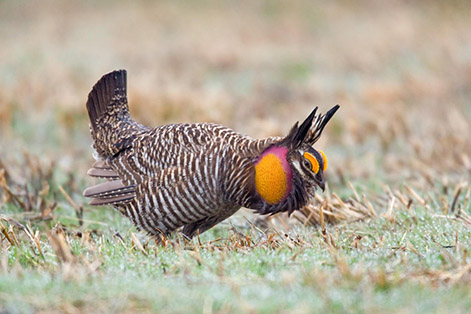The genetic structure of greater prairie-chicken (Tympanuchus cupido pinnatus) populations in Kansas
Investigators:
Mayee Wong, M.S. Student
Project Supervisor:
Dr. Jack F. Cully, Jr.
Funding:
Division of Natural Resources, Fort Riley
Kansas Department of Wildlife, Parks,
and Tourism
Supervisors:
Dr. Jack F. Cully, Jr.
David Jones
Roger Applegate
Location:
Riley, Geary, Lyon and Ottawa Counties in Kansas
Completion:
November 2003
Status:
Completed
Objectives:
What is the genetic structure of the population?
What is the heterozygosity of the species' population in Kansas?
Results:
This study characterizes the genetic pattern of great prairie chicken (Tympanuchus cupido) populations and investigates factors likely influencing these patterns in an effort to provide information critical to the management efforts of this imperiled species. I describe the genetic differentiation of lek groups in three states: Kansas, Missouri, and Oklahoma; and examine the relative influences of geographic distance and mating system on the apparent population structure. One hundred eighty-four individuals form fifteen leks were surveyed at four variable loci by amplification with primers initially found to amplify microsatellite loci in poultry (Gallus gallus). Genotypic distributions across the entire region differed significantly from Hardy-Weinberg expectations for panmixia. Statistically significant geographic heterogeneity was detected among leks (FST = 0.056; p = 0.000). However, analyses of molecular variation (AMOVA) showed geographic partitioning of total genetic variability to be slight: more than 90% was attributable to among individual variation within leks; of the remaining variance, approximately 2% occurred among leks within a state and approximately 5% among states. The average proportion of total gene diversity allocated by AMOVA between leks at a proximity of 2 to 5 km was comparable to that found among leks in regions more than 161 km apart.
The genetic structure of greater prairie chicken populations was greatly influenced by gender-biased dispersal. AMOVA tests conducted separately for each sex indicate males exhibited twice as much among-lek variation as do females. Additionally, estimates of average relatedness among males at a lek site were markedly higher than that among females by lek (RMALES = 0.146, SE = 0.046; RFEMALES = 0.004, SE = 0.024). These findings suggest males were largely responsible for the degree of population differentiation seen among greater prairie chicken leks whereas females promoted gene flow.
Products:
Thesis or Dissertation:
Wong, M. 2003. High spatial homogeneity in a sex-biased mating system: The genetic population structure of greater prairie chickens (Tympanuchus cupido pinnatus) in Kansas, Missouri, and Nebraska. Master's Thesis. Division of Biology, Kansas State University. (Advisor: Cully) .
Professional Presentations:
Wong, M., and J.F. Cully,Jr. 1999. Geographic patterns of Greater Prairie Chicken (Tympanuchus cupido) genetic variability in Kansas, Oklahoma, and Missouri. 61st Midwest Fish and Wildlife Conference, Chicago, IL.